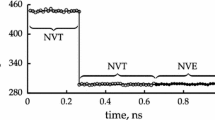Abstract
Two 800-atom cluster models of amorphous copper were constructed utilizing the method of continuous static relaxation of nonrigid spheres developed by the authors. The Morse and Ballog potentials were used to construct and relax the structures. The angular dependence of the x-ray scattering was simulated for both clusters, and a rather appreciable anisotropy was found for them. In order to elucidate the causes of the observed anisotropy, a distribution of atoms in thin sections perpendicular to the direction of the main peak was investigated. Quasiperiodic fluctuations in the occupation numbers of the sections with a period roughly corresponding to the radius of the first coordination sphere were found. A special numerical—graphical analysis showed that the atoms contributing to the main peak form pseudoplanes corresponding to fluctuations in the occupation numbers of the sections. In spite of appreciable differences in the character of interatomic interactions, the density, and the microstructure of the modeled clusters, the pseudocrystalline motifs in both clusters were very similar. A comparison was performed of the results obtained from the scattering pattern for an 800-atom unrelaxed stochastic cluster especially generated for the investigation of the influence of relaxation on the anisotropy. It is shown that the relaxation somewhat increases the anisotropy and order the displacement of the atoms within the sections although on the whole the scattering pattern in all cases is similar. The results obtained correlate well with published data.
Similar content being viewed by others
References
R. Alben, G. S. Cargill, III, and J. Wentzel,Phys. Rev.,B13, 835–842 (1976).
J. G. Wright, Inst. Phys. Conf. Ser., No. 30, Chap. 2, Part 1, 251–259 (1997).
P. Chaudhari, J. F. Graczyk, and S. R. Herd,Phys. Stat. Solidi,B51, 801 (1972).
A. Howie, O. L. Krivanek, and M. L. Rudee,Phil. Mag.,27, 235–255 (1973).
V. B. Kashirin and É. V. Kozlov, “The glass-forming state: a molecular—kinetic aspect,” in: Materialy Mezhdunar. Seminara, Vladivostok, October 15–22, 1990, Part II (1991).
I. M. Torrens,Interatomic Potentials, Academic Press, New York (1972).
C. H. Bennet,J. Appl. Phys.,43, 2727–2734 (1972).
J. L. Finney,Mat. Sci. and Eng.,23, 199–205 (1976).
D. S. Boudreux and H. J. Frost,Phys. Rev.,B23, 1506–1516 (1981).
P. H. Gaskell,J. Non-Cryst. Sol.,32, 207–224 (1979).
D. Himmelblau,Applied Nonlinear Programming [Russian translation], Mir, Moscow (1975).
D. V. Kheerman,Methods for Computer Experiments in Theoretical Physics [in Russian], Nauka, Moscow (1990).
Author information
Authors and Affiliations
Additional information
Translated from Izvestiya Vysshikh Uchebnykh Zavedenii, Fizika, No. 8, pp. 7–12, August, 1993.
Rights and permissions
About this article
Cite this article
Kashirin, V.B., Kozlov, É.V. Anisotropic x-ray scattering from simulated amorphous structures. Russ Phys J 36, 715–719 (1993). https://doi.org/10.1007/BF00562021
Received:
Issue Date:
DOI: https://doi.org/10.1007/BF00562021



